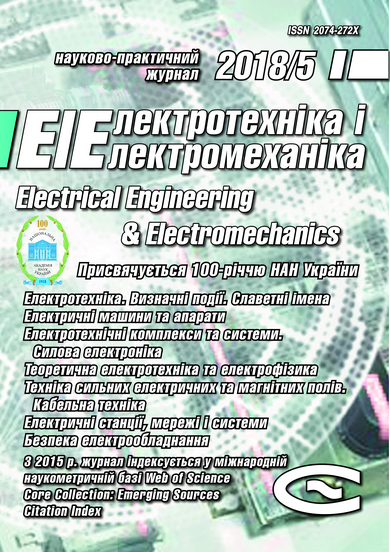METHOD FOR VOLTAGE CONTROL IN CHARGE CIRCUIT OF ELECTRIC DISCHARGE INSTALLATIONS WITH TWO CAPACITORS UNDER NONZERO INITIAL CONDITIONS
DOI:
https://doi.org/10.20998/2074-272X.2018.5.07Keywords:
electric discharge installation, capacitor charge, charge voltage, transients, nonzero initial conditionsAbstract
Purpose. To analyze the transient processes in the charge circuit of electric discharge installations with two capacitors, taking into account the change in the initial conditions of such processes (initial voltage on the capacitors and the initial current in the charge circuit) as well as to develop the method for charge voltage control of such installations using purposeful change of these initial conditions. Methodology. We have applied the concepts of theoretical electrical engineering, the principles of theory of electrical circuits, and mathematical simulation in the software package MathCAD 12. Results. We have obtained analytical expressions and graphical dependencies establishing a quantitative relationship between the value of the maximum charge voltage of an electric discharge installation and the values of the initial voltage on its capacitors and the initial current in the circuit. This allows us to propose the method for the charge voltage control of electric discharge installations with two reservoir capacitors, using a purposeful change in their initial voltages and initial current in the charge circuit. Originality. For the first time, we have found that the charge voltage of the installation can be controlled using two influence mechanisms – either changing the initial current in the charge circuit (by interrupting the transient process of the first capacitor charge at a certain time) or using a nonzero initial voltage on the charged second capacitor. In this case the charge voltage can be varied by 2 times. Practical value. The use of this method makes it possible to obtain discharge pulses of complex shape in the technological load, since the maximum charge voltages of the first capacitor and second one can differ by a factor of 1.5.References
1. Vovchenko A.I., Tertilov R.V. Synthesis of capacitive nonlinear- parametrical energy sources for discharge and pulse technologies. Proceedings of the National University of Shipbuilding, 2010, no.4, pp. 118-124. (Rus).
2. Onishchenko L., Gunko V., Grebennikov I., Bandura A. Capacitors for various electrophysical and technological pulsed power applications. Proceedings of the 1st Intl Congress on Radiation Physics, High Current Electronics, and Modification of Materials.Tomsk, HCEI, 2000, vol.2, pp. 366-367.
3. Casanueva R., Azcondo F.J., Branas C., Bracho S. Analysis, Design and Experimental Results of a High-Frequency Power Supply for Spark Erosion. IEEE Transactions on Power Electronics, 2005, vol.20, no.2, pp. 361-369. doi: 10.1109/tpel.2004.842992.
4. Ivanov A.V., Sinchuk A.V., Ruban A.S. Effect of the technological parameters of the melt treatment by a electric pulse current on the mixing process. Surface Engineering and Applied Electrochemistry, 2012, vol.48, no.2, pp. 180-186. doi: 10.3103/s106837551202007x.
5. Sen B., Kiyawat N., Singh P.K., Mitra S., Ye J.H., Purkait P. Developments in electric power supply configurations for electrical-discharge-machining (EDM). The Fifth International Conference on Power Electronics and Drive Systems PEDS 2003. Singapore, 17-20 November 2003, vol.1, pp. 659-664. doi: 10.1109/PEDS.2003.1282955.
6. Sunka P., Fuciman M., Babicky V., Clupek M., Benes J., Pouckova P., Soucek J. Generation of focused shock waves by multi-channel electrical discharges in water. Conference Record of the Twenty-Fifth IEEE International Power Modulator Symposium, Hollywood, California, USA, 2002, pp. 174-177. doi: 10.1109/MODSYM.2002.1189444.
7. Suprunovska N.I. Analysis of interdependent charge-discharge processes of capacitor in circuits with positive voltage feedback. Technical electrodynamics, 2017, no.4, pp. 14-21. (Rus). doi: 10.15407/techned2017.04.014.
8. Shcherba A.A., Suprunovska N.I. Cyclic transients in the circuits of electric discharge installations taking into account the influence of magnitude and rate of discharge currents rise on resistance of electric spark load. Technical electrodynamics, 2018, no.2, pp. 3-10. (Rus). doi: 10.15407/techned2018.02.003.
9. Kim J.-S., Rim G.-H., Jin Y.-S., Lee H.-S., Suk H.-Y., Kim K.-S., Jung J.-W., Sung G.-Y. A flexible control scheme for current wave forming using multiple capacitor bank units. PPPS-2001 Pulsed Power Plasma Science 2001. 28th IEEE International Conference on Plasma Science and 13th IEEE International Pulsed Power Conference. Digest of Papers (Cat. No.01CH37251). doi:10.1109/ppps.2001.1001846.
10. Suprunovska, N.I.; Shcherba, A.A. Features of the energy interchange between capacitors in the circuit using unidirectional commutator or bidirectional one. Proceedings IEEE International Conference on Intelligent Energy and Power Systems (IEPS-2016), June 7-11, 2016, Kyiv, Ukraine, pp. 6-10. doi: 10.1109/IEPS.2016.7521843.
Downloads
Published
How to Cite
Issue
Section
License
Copyright (c) 2018 N. I. Suprunovska, M. A. Shcherba

This work is licensed under a Creative Commons Attribution-NonCommercial 4.0 International License.
Authors who publish with this journal agree to the following terms:
1. Authors retain copyright and grant the journal right of first publication with the work simultaneously licensed under a Creative Commons Attribution License that allows others to share the work with an acknowledgement of the work's authorship and initial publication in this journal.
2. Authors are able to enter into separate, additional contractual arrangements for the non-exclusive distribution of the journal's published version of the work (e.g., post it to an institutional repository or publish it in a book), with an acknowledgement of its initial publication in this journal.
3. Authors are permitted and encouraged to post their work online (e.g., in institutional repositories or on their website) prior to and during the submission process, as it can lead to productive exchanges, as well as earlier and greater citation of published work.





